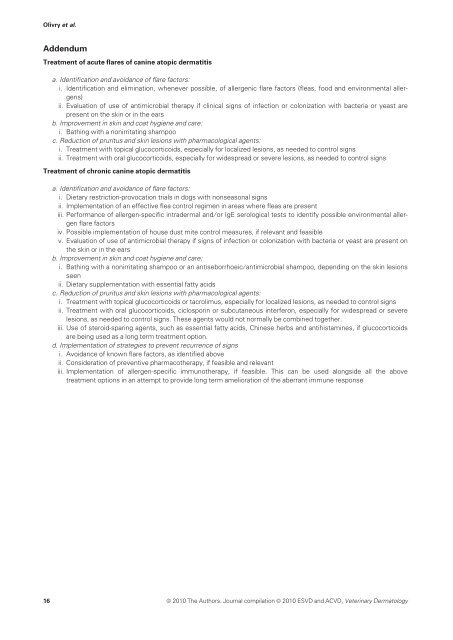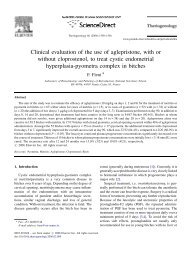Treatment of canine atopic dermatitis: 2010 clinical practice ...
Treatment of canine atopic dermatitis: 2010 clinical practice ...
Treatment of canine atopic dermatitis: 2010 clinical practice ...
You also want an ePaper? Increase the reach of your titles
YUMPU automatically turns print PDFs into web optimized ePapers that Google loves.
Olivry et al.<br />
Addendum<br />
<strong>Treatment</strong> <strong>of</strong> acute flares <strong>of</strong> <strong>canine</strong> <strong>atopic</strong> <strong>dermatitis</strong><br />
a. Identification and avoidance <strong>of</strong> flare factors:<br />
i. Identification and elimination, whenever possible, <strong>of</strong> allergenic flare factors (fleas, food and environmental allergens)<br />
ii. Evaluation <strong>of</strong> use <strong>of</strong> antimicrobial therapy if <strong>clinical</strong> signs <strong>of</strong> infection or colonization with bacteria or yeast are<br />
present on the skin or in the ears<br />
b. Improvement in skin and coat hygiene and care:<br />
i. Bathing with a nonirritating shampoo<br />
c. Reduction <strong>of</strong> pruritus and skin lesions with pharmacological agents:<br />
i. <strong>Treatment</strong> with topical glucocorticoids, especially for localized lesions, as needed to control signs<br />
ii. <strong>Treatment</strong> with oral glucocorticoids, especially for widespread or severe lesions, as needed to control signs<br />
<strong>Treatment</strong> <strong>of</strong> chronic <strong>canine</strong> <strong>atopic</strong> <strong>dermatitis</strong><br />
a. Identification and avoidance <strong>of</strong> flare factors:<br />
i. Dietary restriction-provocation trials in dogs with nonseasonal signs<br />
ii. Implementation <strong>of</strong> an effective flea control regimen in areas where fleas are present<br />
iii. Performance <strong>of</strong> allergen-specific intradermal and ⁄ or IgE serological tests to identify possible environmental allergen<br />
flare factors<br />
iv. Possible implementation <strong>of</strong> house dust mite control measures, if relevant and feasible<br />
v. Evaluation <strong>of</strong> use <strong>of</strong> antimicrobial therapy if signs <strong>of</strong> infection or colonization with bacteria or yeast are present on<br />
the skin or in the ears<br />
b. Improvement in skin and coat hygiene and care:<br />
i. Bathing with a nonirritating shampoo or an antiseborrhoeic ⁄ antimicrobial shampoo, depending on the skin lesions<br />
seen<br />
ii. Dietary supplementation with essential fatty acids<br />
c. Reduction <strong>of</strong> pruritus and skin lesions with pharmacological agents:<br />
i. <strong>Treatment</strong> with topical glucocorticoids or tacrolimus, especially for localized lesions, as needed to control signs<br />
ii. <strong>Treatment</strong> with oral glucocorticoids, ciclosporin or subcutaneous interferon, especially for widespread or severe<br />
lesions, as needed to control signs. These agents would not normally be combined together.<br />
iii. Use <strong>of</strong> steroid-sparing agents, such as essential fatty acids, Chinese herbs and antihistamines, if glucocorticoids<br />
are being used as a long term treatment option.<br />
d. Implementation <strong>of</strong> strategies to prevent recurrence <strong>of</strong> signs<br />
i. Avoidance <strong>of</strong> known flare factors, as identified above<br />
ii. Consideration <strong>of</strong> preventive pharmacotherapy, if feasible and relevant<br />
iii. Implementation <strong>of</strong> allergen-specific immunotherapy, if feasible. This can be used alongside all the above<br />
treatment options in an attempt to provide long term amelioration <strong>of</strong> the aberrant immune response<br />
16 ª <strong>2010</strong> The Authors. Journal compilation ª <strong>2010</strong> ESVD and ACVD, Veterinary Dermatology








